TRAVEL TIPS: GUIDE TO DAY TRIP AROUND CHARMING PENANG ISLAND
Penang Island, Malaysia, is most famous for its amazingly rich cultural mix of Chinese, Indian, Malay, and European cultures. That blend is a result of Penang’s historical beginnings as a major port on the Asian trading route. Georgetown, Penang is now a UNESCO World Heritage City. Thus, most visitors to Penang spend a majority, if not all, of their time in Georgetown touring its abundant and varied temples, clan houses, museums, and other cultural attractions. Here are 10 Free Things to do in Penang for further reading.
Penang is also somewhat well-known for its natural attractions: its well-developed tourist beach- Batu Ferringhi, Penang Hill, the Botanic Gardens, and Penang National Park.
Beyond these most acclaimed sites in and around Georgetown, though, there’s much more to Penang. After all, it is a lush tropical island situated in the warm Andaman Sea. Outside Georgetown’s vast sprawl you’ll find cool winding mountain roads through dense tropical forests, undisturbed fishing villages, lazy rural life amidst flat rice fields, gorgeous wooden country houses with elaborate decorative touches, and a few isolated beaches.
You can reach all of Penang’s rural sights on an easy day trip around the island. A complete circumnavigation of Penang is only 70 km. If that sounds enticing, read on:
Visitors have 3 options for making a day trip around Penang island:
1. Public buses
2. Rental motorbike or car
3. Bicycle
Things to see and do:
* remote tiny fishing villages, some with colorful wooden boats
* remote beaches
* central flat rural valley with rice fields
* charming Malay-style wood country houses
* Chinese Christian Church in Balik Pulau town
* Nutmeg Factory
* Fruit Farm
* Butterfly Farm
* Dammed lake
* Penang National Park
* Spice Garden
* Ferringhi Beach
Balik Pulau is the only sizable town in rural Penang. Others are tiny villages or collection of houses. The only point of interest in Balik Pulau is a quirky Chinese Christian church, which sports both written English and Chinese on the exterior, as well as mixed architectural elements. It’s about one block from the town center. There are many local shops to eat at, including Malay, Chinese, and Indian in the town center and the roads leading into town.
Many charming Malay-style country houses line the flat road north of Balik Pulau, until the road begins winding up into mountains, about 8 km north of town.
Tiny fishing villages are found along Penang’s hilly south coast and at the end of many side roads heading out to the west coast Penang’s central north-south road. Just follow a road until it ends, generally 4-10 km.
The nutmeg factory, fruit farm, butterfly farm, and dammed lake are all located on the shady mountain road between Penang’s north coast at Teluk Bahang and Balik Pulau town.
Batu Ferringhi beach, Penang National Park, the Spice Garden, and several tiny beaches line Penang’s northern coastal road.
See below for detailed descriptions of each area of the island. (under ‘motorbike/car rental’)
Trip by Public buses
Despite Lonely Planet’s claim that you cannot go around Penang Island by bus, you can indeed. You will have to take 3 buses: 101, 501, and 401E. You can make the journey either clockwise or counter clockwise. The only glitch is that bus 501, which covers the interior central section of the island, only runs once very 2 hours.
Therefore, I was advised by the tourist office, it’s best to travel clockwise, first heading south past the airport then turning westward over the mountains and down into the central town of Balik Pulau. That way you can await the second bus, 501, in town. If you head counterclockwise, first along Penang’s north coast, you’ll end up waiting for 501 out beside the road. Your choice.
You could also pick up a bus schedule from the Tourist Office, and then try to plan your trip based on the estimated time of arrival of bus 501. Of course, if you miss it by a few minutes, you’ll have a 2-hour wait until the next bus rolls along.
In any event, the 3 buses are:
401E- Georgetown to Balik Pulau. Catch at the ferry bus terminal. Runs every 30 minutes
501- Balik Pulau to Teluk Bahang on Penang’s north coast near the National Park. Runs once/ 2 hours
101- Teluk Bahang to Georgetown. Catch at Teluk Bahang round about. Runs every 10-15 minutes
Taking the buses, you’ll be able to see most of the island, but you won’t be able to reach the more isolated fishing villages or beaches. And it’s certainly not very convenient to hop on and off at will, especially for the central stretch covered by bus 501.
Rent a motorbike/car and drive around Penang
Driving a motorbike/car or riding a bike gives you maximum flexibility on your island tour. You can reach the more remote spots, explore exactly where you want, and stop anytime/anywhere you want.
Motorbikes are cheap and easy to rent in Georgetown. A standard bike costs 30-40 RM ($10-13 US) per day. You’ll need to buy 2-3 Liters of petrol to see the entire island, depending on how much extra side-road explorations you do. That much fuel will cost 4-6 RM ($1.35-2 US)
Personally, I recommend renting a motorbike since Penang’s roads are quite narrow and traffic often heavy. But if you prefer driving a car, go for it.
The only document you need to rent a bike is your driver’s license (doesn’t’ need to be international) which the shop will photocopy, and a cash deposit of about 150 RM / $50 US. You can deposit foreign currency and get it back when you return. Sorry, I’m not sure of the specifics of car rental on Penang.
Be aware that Malaysians drive on the left side, like England and Australia, but opposite the US and Europe. Like most Asian traffic, it can be heavy with tight squeezes and some fast drivers. However, it’s not nearly as hectic as China, Bali or Thailand. If you think you’ll be safe handling the roads and traffic, then a motorbike or car rental is the way to go.
Again, you can travel either clockwise or counter clockwise. Following is a description of the roads, terrain, and attractions in each section of the island.
East coast and south. Heading directly south from Georgetown, more or less along the east coast, the large highways are flat and pass mainly through completely developed areas. The area is pretty much urban sprawl all the way past the airport. From Penang Bridge southward, there are a lot more trees lining the roads plus scenic views of nearby Jerekuk Island, the mainland, and Penang’s pretty interior mountains.
At Batu Maung the road turns west, more or less along Penang’s south coast and the road becomes hilly. Two or three fishing villages line the south coast. The most scenic and remote is Gertuk Sungul, which is 6 km off the main road on a very hilly, shady, scenic coastal road.
There’s one big hill to climb up and over to reach Penang’s central flat valley. Balik Pulau, the only sizable town, is a few km north of the western side of the hill. Southwest of Balik Pulau is another tiny fishing village called Pulau Betong. There’s nothing really to do or see there, but 6 km beyond the village is a wonderful remote white sand beach at the end of another hilly, shady coastal road. The beach road ends at an official-looking compound, which is a camp for young Malays serving their military duty just after high school. Usually camp is not in session and the beach is empty, save for a few locals out fishing.
Penang’s central valleyruns north-south for about 15-20 km. It’s perfectly flat and scorching hot in midday. The road is graced with lovely old wooden Malay-style country homes, sporting many carved wooden lattices, porches, and interesting architectural designs.
Penang’s west coast doesn’t offer many attractions. The coast is lined mostly by dense mangrove forests with no beaches. Off the main road, a few side roads lead to tiny fishing villages. None have much to see besides small Chinese temples and perhaps some local boats. But it is interesting to see how the locals live.
On the main road, about 8 km north of Balik Pulau, the road suddenly heads up into more shady hills, as it climbs up over another mountain to the north coast, ending at Teluk Pulau. Along that road you’ll find a few scenic outlooks with great views over Penang’s west coast. The Nutmeg Factory, Fruit Farm, Butterfly Farm, and dammed lake are all located along the mountain road. In my opinion, the nutmeg factory is the most interesting and it’s free! See my post 10 Free Things to do in Penang. The Fruit Farm is quite expensive- 45 RM- for a 30-minute tour of fruit orchards. Plus, the whole place is very touristy and commercialized. Many tour groups go there. Ditto for the Butterfly Farm.
Just before reaching the north coast, and hovering over Teluk Bahang,is a large scenic dam. It’s a nice spot to chill out and relax if you like lakes. There’s a pavilion or two, roadside.
Teluk Bahang is another larger fishing village with not much interest. Three km further west, at the end of Penang’s north coast road, is Penang National Park. It’s a great park with free entry, hiking trails, and remote beaches. They also allow free camping at two beaches.
From the National Park, it’s 20 km to Georgetown along a mostly hilly, winding narrow coastal road. A few small beaches line the coast. Stop at any to relax, suntan, or swim. Note that they sit right beside the busy road. Most have drink and snack kiosks, especially in the evenings. Penang’s lovely Spice Garden is a located between Teluk Bahang and Batu Ferringhi. There’s also a beach and food stalls there. Batu Ferringhi, Penang’s most beautiful but most developed beach, is 3 km from Teluk Bahang round-about and 16 km from Georgetown.
Cycling Penang Island
If you’re a long distance cyclist or a cycle-tour enthusiast, you can easily cycle around Penang Island in one day. Teluk Bahang, on Penang’s north coast, 20 km from Georgetown does have a few home stays. Batu Ferringhi beach has many upscale hotels and a few guest houses for budget travelers. So another option is the break the trip into 2 days, though most of the trip, including all the climbing, will be on one day- 50 km. I could not locate any other accommodation of any sort in the other areas of the island.
Cycling stats:
Total distance: 70 km.
You have to climb 2 major hills, pedal some slightly hilly windy coastal roads.
The rest is flat.
See above for road and area descriptions.
Below are the distances and road conditions:
Road distances, heading south from Georgetown:
central Georgetown to Penang bridge: 10 km. / flat / big highways, some with wide shoulders
Penang Bridge to Batu Maung: 14 km / flat / some shady trees, wide shoulder, scenic views
Batu Maung to Sungai Batu: 6 km / slightly hilly
Sungai Batu to Balik Pulau town in central Penang: 19 km / up over mountain, as follows:
hill: 5 km climb up / 8 km down hill to Penang’s central valley
base of hill to central Balik Pulau town 6 km
*side trip on south coast to Gertuk Sungul: Sungai Batu to Gertuk Sungul 6 km OW / hilly coastal road
*side trip in central Penang to southern fishing village and beach:
base of hill westward to Pulau Betong fishing village 8 km
Pulau Betong to remote beach 6 km / hilly shaded coastal road
central Balik Pulau town to Teluk Bahang: 21 km / flat road then up over mountain as follows:
8 km flat / 5 km climb / 8 km descent to Penang’s north coast
*side trip to Penang National Park:
Teluk Bahang west to National Park: 3 km / flat. A few home stays are located in Teluk Bahang.
Teluk Bahang to Georgetown 20 km. Hilly, shaded, coastal road. Narrow / Lots of traffic / no berm
Whichever way you choose to explore Penang Island off the beaten path, it’s a fun, memorable way to spend a day on the island. Enjoy!
QUESTIONS:
Have you been to Penang? What did you like most about it?
What’s your favorite island in SE Asia?






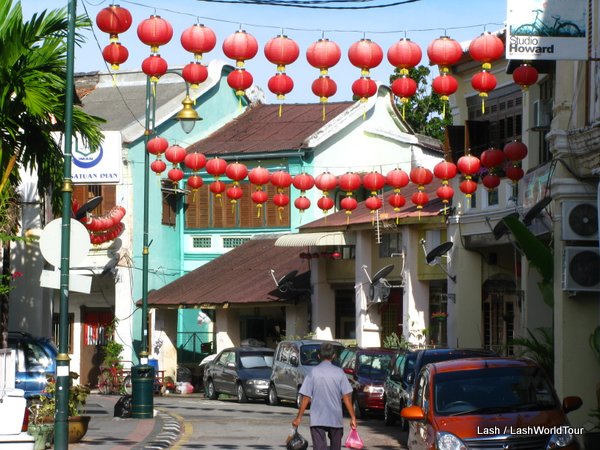
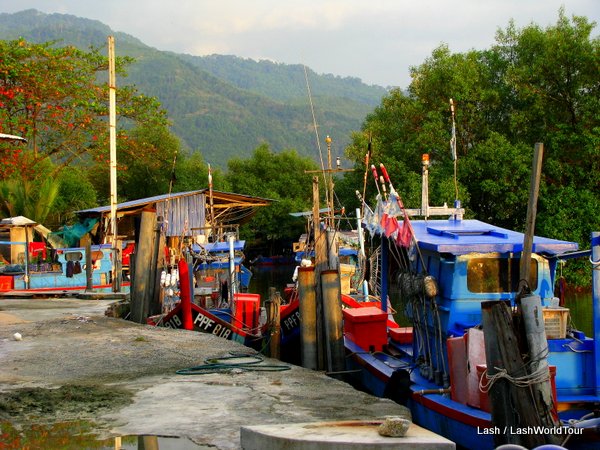

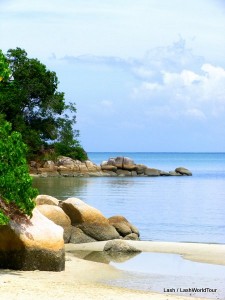
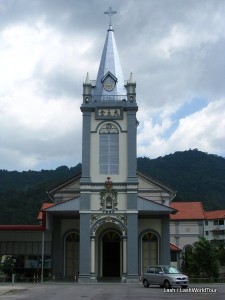
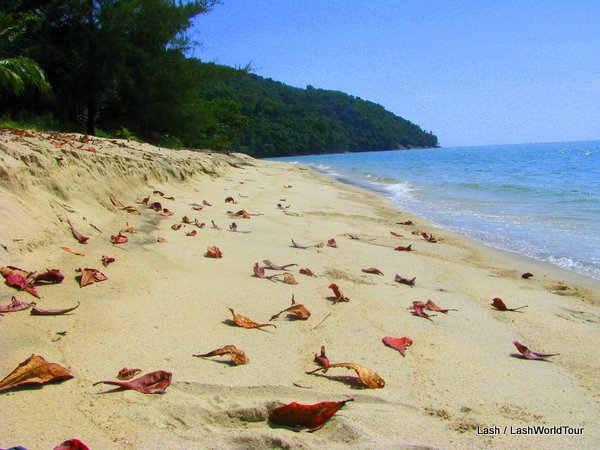
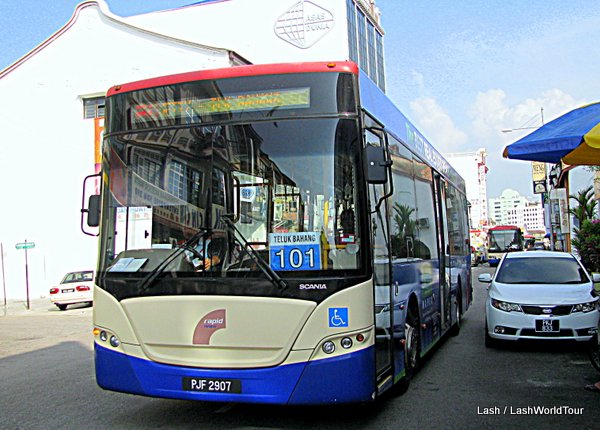
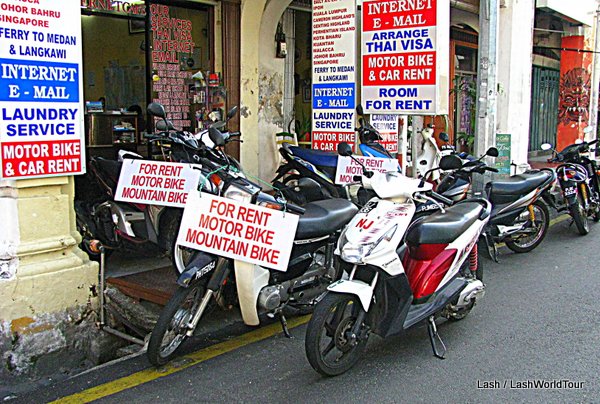
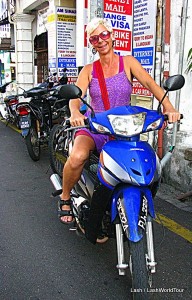
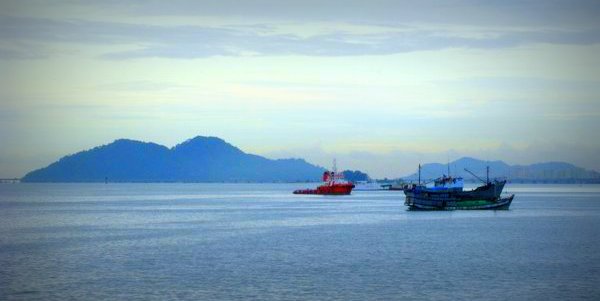

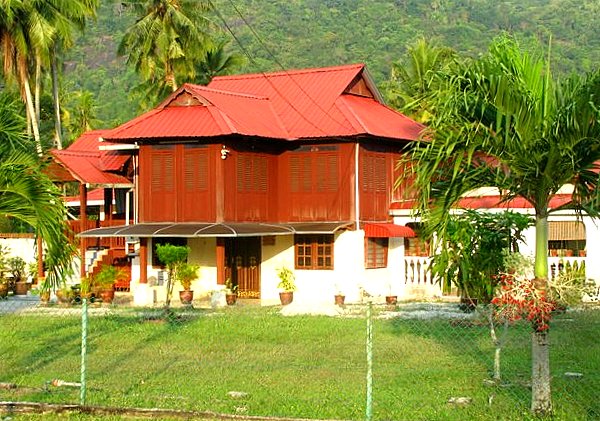
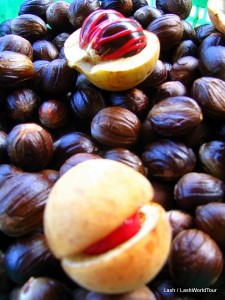

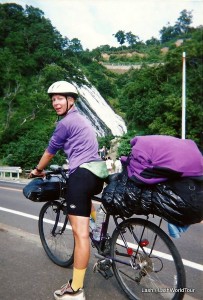
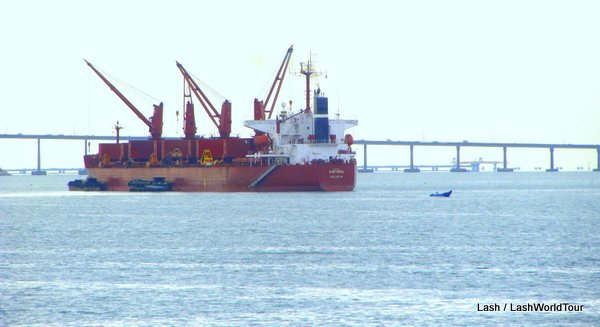

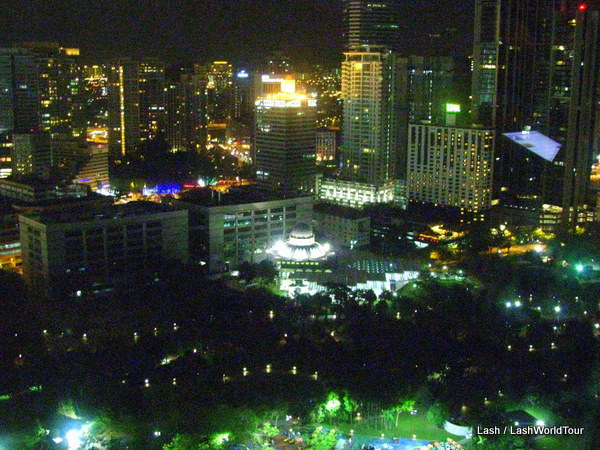




 Hi! I'm Lash, an American nomadic world traveler who's been traveling solo since 1998. I’m passionate about traveling the world nomadically and then sharing it all with you. I hope to inspire you to travel the world, to entertain you with tales from the road, and to help you reach your travel dreams. Welcome!
Hi! I'm Lash, an American nomadic world traveler who's been traveling solo since 1998. I’m passionate about traveling the world nomadically and then sharing it all with you. I hope to inspire you to travel the world, to entertain you with tales from the road, and to help you reach your travel dreams. Welcome! 




33 pings
Skip to comment form ↓
10 FREE THINGS TO DO IN PENANG- MALAYSIA
2012/05/10 at 6:25 am (UTC 8) Link to this comment
[…] You’ll need your driver’s license and a cash deposit. See details on my post: Guide to Day-trip Around Charming Penang Island.Whiteaways Arcade, Lebuh Pantai (Beach STreet) Penang10. Learn about Penang’s colonial […]